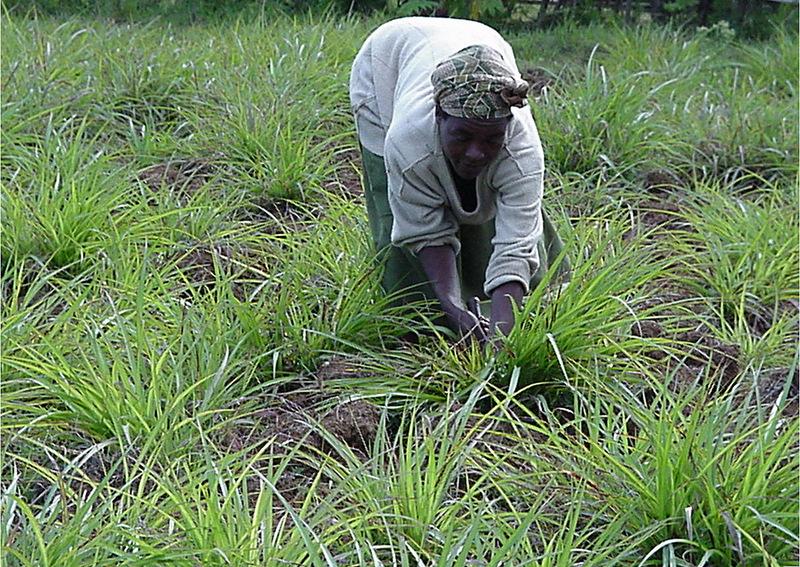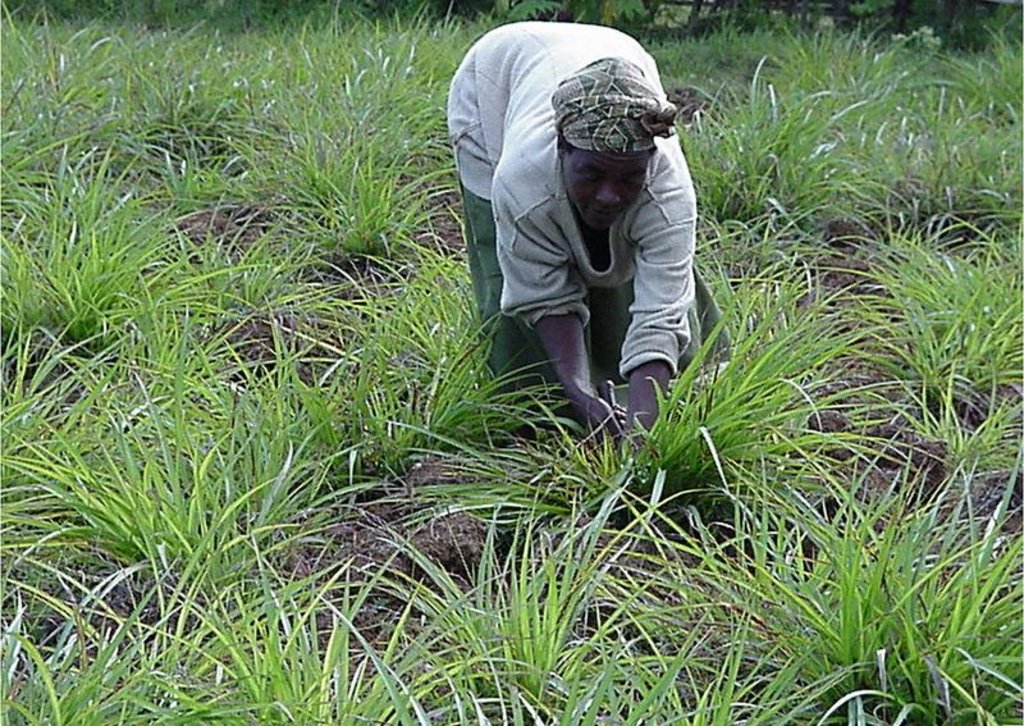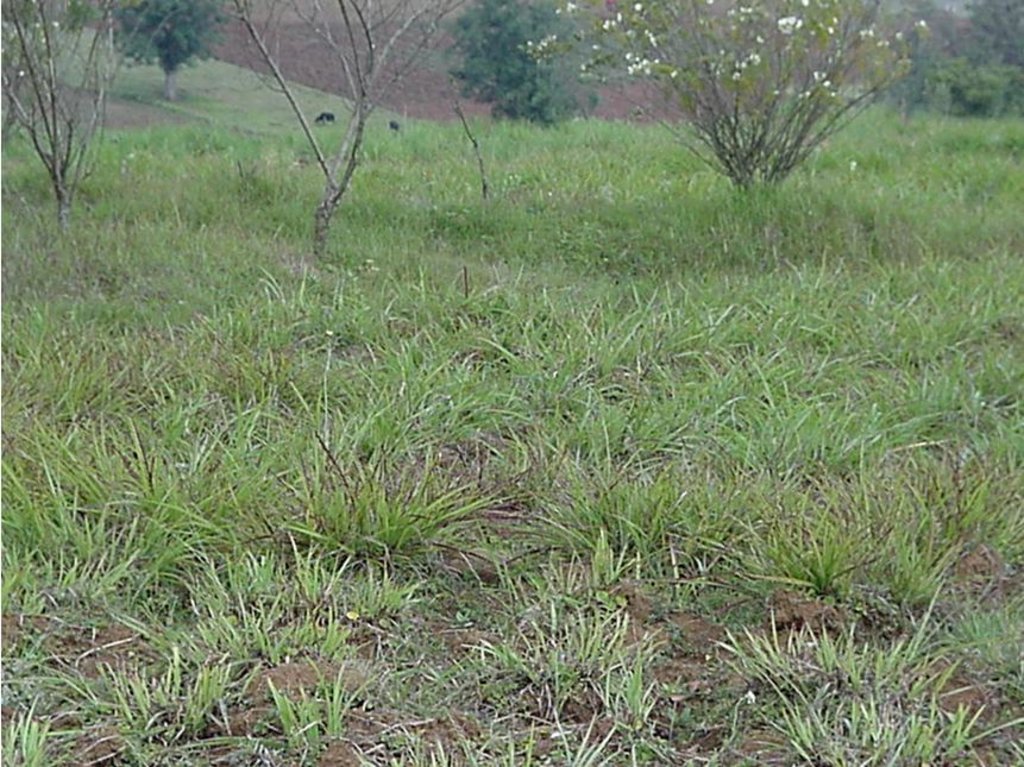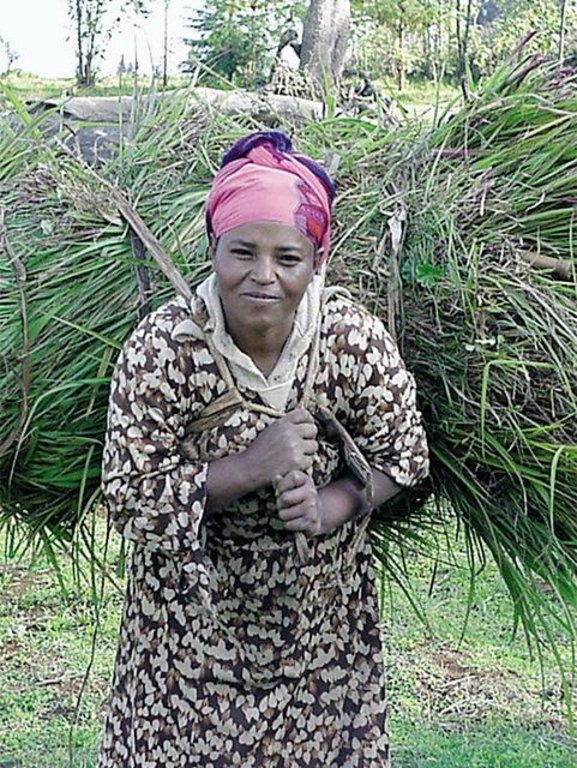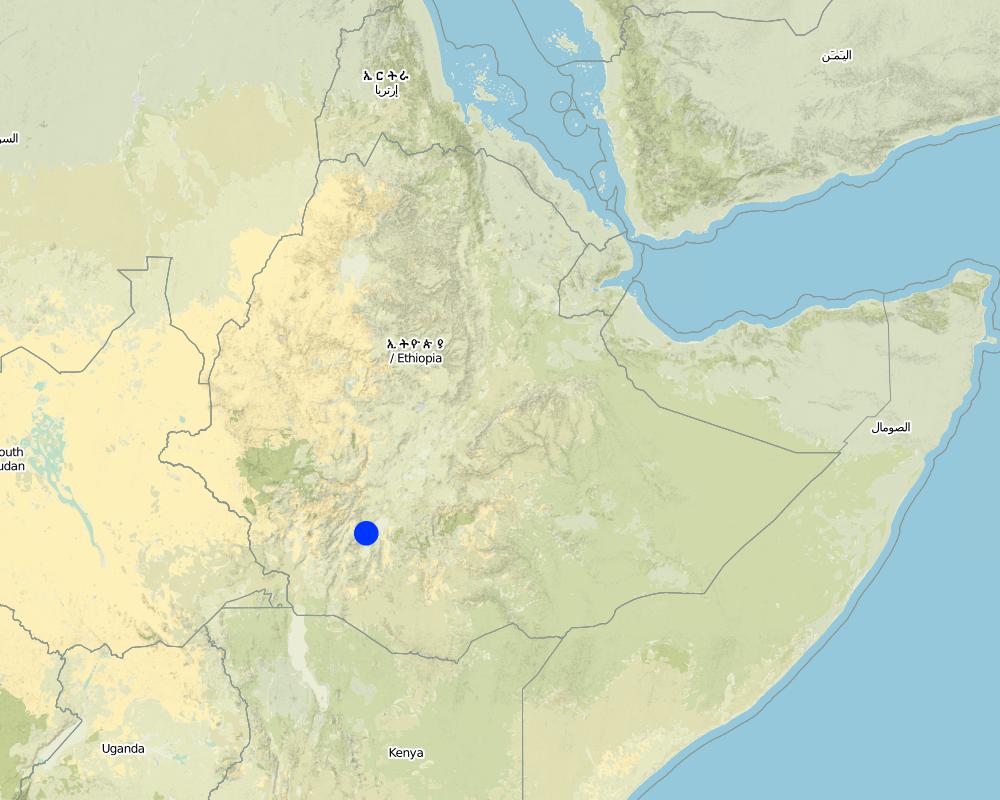Grazing Land Improvement [Ethiopia]
- Creation:
- Update:
- Compiler: Daniel Danano
- Editor: –
- Reviewers: Donia Mühlematter, Alexandra Gavilano, Fabian Ottiger
technologies_954 - Ethiopia
View sections
Expand all Collapse all1. General information
1.2 Contact details of resource persons and institutions involved in the assessment and documentation of the Technology
Key resource person(s)
SLM specialist:
SLM specialist:
SLM specialist:
Mesfin Melaku
Arbaminch office of Agriculture
Ethiopia
1.3 Conditions regarding the use of data documented through WOCAT
The compiler and key resource person(s) accept the conditions regarding the use of data documented through WOCAT:
Yes
2. Description of the SLM Technology
2.1 Short description of the Technology
Definition of the Technology:
It is a technique which increases the productivity of grasslands per unit area through activities of soding and direct sawing of grass species.
2.2 Detailed description of the Technology
Description:
Grazing land improvement is based on enclosures and planting of improved grass and fodder trees to enhance fodder and consequently livestock production and simultaneously control land degradation. This case study focuses on the highly populated humid highlands of Ehtiopia where the little remaining grazing land areas are overused and unter enormous pressure.
Establishment / maintenance activities and inputs: The technology involves a combination of management, agronomic and vegetative measures: fencing to exclude open access, application of compost to improve soil fertility, planting of improved local and exotic fodder species, including multipurpose shrubs/trees (including nitrogen fixing species) leumes, and the local desho grass. Desho has a high nutritive value and ensures regular cuts. It is planted by splits, which have high survival rates and establish better than grasses which are seeded. Other grass seeds and legumes are mixed with fodder tree seeds and then broadcast. Legumes include alfalfa and clovers in some cases. The area is permanently closed for livestock. Fodder is cut and carried for stall-feeding and once a year, grass is cut for hay, which is stored to feed animals during the dry season.
2.3 Photos of the Technology
2.5 Country/ region/ locations where the Technology has been applied and which are covered by this assessment
Country:
Ethiopia
Region/ State/ Province:
Southern Nation and Nationalities and Peoples Region
Further specification of location:
Chencha, Ethiopia
Comments:
It is an area reserved for the demonstration of the improved management of pastures
Map
×2.7 Introduction of the Technology
Specify how the Technology was introduced:
- through projects/ external interventions
Comments (type of project, etc.):
the technology is not totally new but new improvement techniques have been included to increase productivity of land and improve quality of grazing.
3. Classification of the SLM Technology
3.1 Main purpose(s) of the Technology
- improve production
3.2 Current land use type(s) where the Technology is applied
Land use mixed within the same land unit:
Yes
Specify mixed land use (crops/ grazing/ trees):
- Silvo-pastoralism

Cropland
- Annual cropping
- Tree and shrub cropping
Annual cropping - Specify crops:
- fodder crops - alfalfa
- leumes,, local desho grass, lucerne
Number of growing seasons per year:
- 2
Specify:
Longest growing period in days: 230 Longest growing period from month to month: Aug - Feb Second longest growing period in days: 150 Second longest growing period from month to month: Mar - Jun

Grazing land
Intensive grazing/ fodder production:
- Cut-and-carry/ zero grazing
- Improved pastures
Comments:
Major land use problems (compiler’s opinion): shortage of land, population pressure, soil erosion
Major land use problems (land users’ perception): soil erosion, low fertility status of the soil, low Agricultural production
Future (final) land use (after implementation of SLM Technology): Mixed: Ms: Silvo-pastoralism
Constraints of settlement / urban
3.3 Has land use changed due to the implementation of the Technology?
Land use mixed within the same land unit:
Yes
Specify mixed land use (crops/ grazing/ trees):
- Silvo-pastoralism

Grazing land

Settlements, infrastructure
Remarks:
Constraints of settlement / urban
3.4 Water supply
Water supply for the land on which the Technology is applied:
- rainfed
3.5 SLM group to which the Technology belongs
- minimal soil disturbance
3.6 SLM measures comprising the Technology

agronomic measures
- A2: Organic matter/ soil fertility

vegetative measures
- V2: Grasses and perennial herbaceous plants

management measures
- M2: Change of management/ intensity level
Comments:
Main measures: agronomic measures, vegetative measures, management measures
Type of agronomic measures: manure / compost / residues
Type of vegetative measures: scattered / dispersed
3.7 Main types of land degradation addressed by the Technology

soil erosion by water
- Wt: loss of topsoil/ surface erosion

soil erosion by wind
- Et: loss of topsoil

chemical soil deterioration
- Cn: fertility decline and reduced organic matter content (not caused by erosion)

biological degradation
- Bc: reduction of vegetation cover
- Bs: quality and species composition/ diversity decline
Comments:
Main type of degradation addressed: Wt: loss of topsoil / surface erosion, Cn: fertility decline and reduced organic matter content
3.8 Prevention, reduction, or restoration of land degradation
Specify the goal of the Technology with regard to land degradation:
- restore/ rehabilitate severely degraded land
Comments:
Main goals: rehabilitation / reclamation of denuded land
4. Technical specifications, implementation activities, inputs, and costs
4.1 Technical drawing of the Technology
Technical specifications (related to technical drawing):
SNNPR
Technical knowledge required for field staff / advisors: high
Technical knowledge required for land users: moderate
Main technical functions: improvement of ground cover
Secondary technical functions: increase in soil fertility
Agronomic measure: Grass planting
Material/ species: grasses
Agronomic measure: Soding
Material/ species: grasses
Agronomic measure: Tree planting
Material/ species: seedlings
Scattered / dispersed
Vegetative material: G : grass
Number of plants per (ha): 80000
Spacing between rows / strips / blocks (m): 0.2m
Width within rows / strips / blocks (m): 0.5x0.5
Trees/ shrubs species: tree lucern
Grass species: Desho-a local grass with better performance
Slope (which determines the spacing indicated above): 3.00%
Change of land use practices / intensity level: additional compost
Control / change of species composition: phalaries and Desho
4.2 General information regarding the calculation of inputs and costs
other/ national currency (specify):
Birr
Indicate average wage cost of hired labour per day:
0.50
4.3 Establishment activities
| Activity | Timing (season) | |
|---|---|---|
| 1. | fencing | Dry season |
| 2. | transplanting | onset of rain |
| 3. | Préparer les jeunes plants en pépinières (division des touffes, semis des arbres) | |
| 4. | Préparer le lit de semence (houe à main, en partie charrue à bœuf) | |
| 5. | Planter les herbes divisées et les espèces d’arbustes / arbres en ligne et sur les diguettes de conservation ; semer les graines des graminées à la volée | au début de la saison des pluies |
| 6. | Préparer le compost/fumier (cendres, fumier, litière de feuilles, terre, eau) | |
| 7. | Appliquer le compost (un mois après la plantation) | |
| 8. | Sarcler |
4.4 Costs and inputs needed for establishment
| Specify input | Unit | Quantity | Costs per Unit | Total costs per input | % of costs borne by land users | |
|---|---|---|---|---|---|---|
| Labour | Labour | ha | 1.0 | 320.0 | 320.0 | 56.0 |
| Equipment | Machine use | ha | 1.0 | 22.0 | 22.0 | 56.0 |
| Plant material | Seeds | ha | 1.0 | 710.0 | 710.0 | 56.0 |
| Total costs for establishment of the Technology | 1052.0 | |||||
| Total costs for establishment of the Technology in USD | 1052.0 | |||||
Comments:
Duration of establishment phase: 132 month(s)
4.5 Maintenance/ recurrent activities
| Activity | Timing/ frequency | |
|---|---|---|
| 1. | ploughing | dry season / 3 times |
| 2. | fence maintenance | throughout the year /2-3 times/year |
| 3. | replanting & fertilizing | |
| 4. | weeding | On set of rain |
4.6 Costs and inputs needed for maintenance/ recurrent activities (per year)
| Specify input | Unit | Quantity | Costs per Unit | Total costs per input | % of costs borne by land users | |
|---|---|---|---|---|---|---|
| Labour | Labour | ha | 1.0 | 35.0 | 35.0 | 100.0 |
| Equipment | Machine use | ha | 1.0 | 4.0 | 4.0 | 100.0 |
| Plant material | Seeds | ha | 1.0 | 87.0 | 87.0 | 100.0 |
| Total costs for maintenance of the Technology | 126.0 | |||||
| Total costs for maintenance of the Technology in USD | 126.0 | |||||
Comments:
Seedlings are given by the government for initial establishment. For further extension of area and replanting, the land users set up their own nurseries. After 2-3 years maintenance costs decrease substantially as the grass cover closes up and maintenance activities such as replanting and compost application are reduced or cease. The local daily wage is about US$ 0.70 a day.
4.7 Most important factors affecting the costs
Describe the most determinate factors affecting the costs:
soil fertility, labour,manure (compost)
5. Natural and human environment
5.1 Climate
Annual rainfall
- < 250 mm
- 251-500 mm
- 501-750 mm
- 751-1,000 mm
- 1,001-1,500 mm
- 1,501-2,000 mm
- 2,001-3,000 mm
- 3,001-4,000 mm
- > 4,000 mm
Specify average annual rainfall (if known), in mm:
1100.00
Agro-climatic zone
- humid
Thermal climate class: tropics (wett dega)
5.2 Topography
Slopes on average:
- flat (0-2%)
- gentle (3-5%)
- moderate (6-10%)
- rolling (11-15%)
- hilly (16-30%)
- steep (31-60%)
- very steep (>60%)
Landforms:
- plateau/plains
- ridges
- mountain slopes
- hill slopes
- footslopes
- valley floors
Altitudinal zone:
- 0-100 m a.s.l.
- 101-500 m a.s.l.
- 501-1,000 m a.s.l.
- 1,001-1,500 m a.s.l.
- 1,501-2,000 m a.s.l.
- 2,001-2,500 m a.s.l.
- 2,501-3,000 m a.s.l.
- 3,001-4,000 m a.s.l.
- > 4,000 m a.s.l.
Comments and further specifications on topography:
Landforms: Also footslopes
Slopes on average: Also hilly
5.3 Soils
Soil depth on average:
- very shallow (0-20 cm)
- shallow (21-50 cm)
- moderately deep (51-80 cm)
- deep (81-120 cm)
- very deep (> 120 cm)
Soil texture (topsoil):
- medium (loamy, silty)
- fine/ heavy (clay)
Topsoil organic matter:
- medium (1-3%)
- low (<1%)
If available, attach full soil description or specify the available information, e.g. soil type, soil PH/ acidity, Cation Exchange Capacity, nitrogen, salinity etc.
Soil fertility is low-medium
Soil drainage/infiltration is good
Soil water storage capacity is medium-low
5.6 Characteristics of land users applying the Technology
Market orientation of production system:
- subsistence (self-supply)
Off-farm income:
- 10-50% of all income
Relative level of wealth:
- very poor
- poor
Individuals or groups:
- individual/ household
Level of mechanization:
- manual work
Indicate other relevant characteristics of the land users:
Land users applying the Technology are mainly common / average land users
Population density: 200-500 persons/km2
Annual population growth: 3% - 4%
10% of the land users are average wealthy and own 10% of the land.
65% of the land users are poor and own 65% of the land.
25% of the land users are poor and own 25% of the land.
Off-farm income specification: about 50%
5.7 Average area of land used by land users applying the Technology
- < 0.5 ha
- 0.5-1 ha
- 1-2 ha
- 2-5 ha
- 5-15 ha
- 15-50 ha
- 50-100 ha
- 100-500 ha
- 500-1,000 ha
- 1,000-10,000 ha
- > 10,000 ha
Is this considered small-, medium- or large-scale (referring to local context)?
- small-scale
Comments:
Size of grazing land per household: 0.5-1 ha (land is scarce commodity in this woreda)
5.8 Land ownership, land use rights, and water use rights
Land ownership:
- state
Land use rights:
- open access (unorganized)
- individual
Comments:
Land use rights: individual for cropland, open access for grazing land
6. Impacts and concluding statements
6.1 On-site impacts the Technology has shown
Socio-economic impacts
Production
fodder production
fodder quality
wood production
Income and costs
farm income
Socio-cultural impacts
health situation
Comments/ specify:
Improved household diets, e.g. Milk
community institutions
national institutions
Comments/ specify:
Volonté accrue de l institution nationale d’aider / soutenir les groupes d'agriculteurs organisés (p. ex. institutions communautaires)
SLM/ land degradation knowledge
Willingness of national institution to assist
Comments/ specify:
e.g. community institutions
Willingness of national institution to assist
Comments/ specify:
e.g. community institutions
Ecological impacts
Soil
soil moisture
soil cover
soil loss
nutrient cycling/ recharge
Biodiversity: vegetation, animals
plant diversity
Other ecological impacts
Soil fertility
6.2 Off-site impacts the Technology has shown
downstream flooding
downstream siltation
wind transported sediments
Transported sediments
6.3 Exposure and sensitivity of the Technology to gradual climate change and climate-related extremes/ disasters (as perceived by land users)
Climate-related extremes (disasters)
Meteorological disasters
| How does the Technology cope with it? | |
|---|---|
| local rainstorm | well |
Comments:
Tolérance aux pluies de forte intensité, aux orages
6.4 Cost-benefit analysis
How do the benefits compare with the establishment costs (from land users’ perspective)?
Short-term returns:
slightly positive
Long-term returns:
very positive
How do the benefits compare with the maintenance/ recurrent costs (from land users' perspective)?
Short-term returns:
positive
Long-term returns:
very positive
Comments:
La production de lait com-pense certains coûts élevés d’investis-sement (avant, la production était faible)
6.5 Adoption of the Technology
Of all those who have adopted the Technology, how many did so spontaneously, i.e. without receiving any material incentives/ payments?
- 0-10%
Comments:
30% of land user families have adopted the Technology with external material support
122 land user families have adopted the Technology with external material support
Comments on acceptance with external material support: estimates
16 land user families have adopted the Technology without any external material support
Comments on spontaneous adoption: estimates
There is a little trend towards spontaneous adoption of the Technology
Comments on adoption trend: it requires more effort to make more farmers participate for the higher rate of adoption of the technology
6.7 Strengths/ advantages/ opportunities of the Technology
| Strengths/ advantages/ opportunities in the land user’s view |
|---|
|
milk and livestock production increased How can they be sustained / enhanced? approprate extension system |
| Strengths/ advantages/ opportunities in the compiler’s or other key resource person’s view |
|---|
|
the technology can create awrness on how can the farmer able to develop forage How can they be sustained / enhanced? continiuous training and follow up |
| grass species with better biomass yield are introduced |
| the productivity of grass increased and there by the production of livestock increased |
6.8 Weaknesses/ disadvantages/ risks of the Technology and ways of overcoming them
| Weaknesses/ disadvantages/ risks in the land user’s view | How can they be overcome? |
|---|---|
| Needs high fertilizer application | focus mainly on organic fertilizers. |
| High pressure on remaining grazing areas. | keep animals in stall (stable) or park, at least part of the day and during the night and introduce cut-and-carry more widely. |
| Besoin d’une application importante d’engrais | se concentrer surtout sur les engrais organiques |
| Forte pression sur les pâturages restants | garder les animaux en stabulation (étable) ou en parc, au moins une partie de la journée et pendant la nuit et introduire plus largement l’affouragement en vert |
| Weaknesses/ disadvantages/ risks in the compiler’s or other key resource person’s view | How can they be overcome? |
|---|---|
| At the initial stage of establishment it is very labour intensive | use of improved land preparation methods such as oxen ploughing. |
| It is an expensie technology (availability of cash for inputs, particularly seedlings) | produce seedlings of improved species and compost in backyards. |
7. References and links
7.2 References to available publications
Title, author, year, ISBN:
Adane Dinku, Chencha Wereda, Natural Resources Management Annual Report, 2001 and 2002; Danano, D (2008, unpublished): Soil and Water Conservation Practices for Sustainable Land Management
Links and modules
Expand all Collapse allLinks
No links
Modules
No modules


